Hanwoo cattle from Korea
Origins of cattle
A study of domestication in China is required to understand the origins of the Korean Hanwoo cattle breed. There are roughly one hundred million cattle from fifty three indigenous breeds in present day China. Wild aurochs were present more than ten thousand years ago in different geographic areas (Chen et al., 2018).
Aurochs were the large and powerful predecessors of domestic cattle. From the Bos primigenius genus they weighed between 300 and 800 kg, inhabiting a variety of habitats across Eurasia, but were gradually driven out by people who used their domesticated relatives to exploit their habitat.
Taurine cattle (Bos taurus) were domesticated from Bos primigenius primigenius in the Fertile Crescent during the Neolithic, more than 10,000 years ago. They are illustrated in red colour on the map drawn by Pitt, Sevane and Nicolazzi et al., in 2019.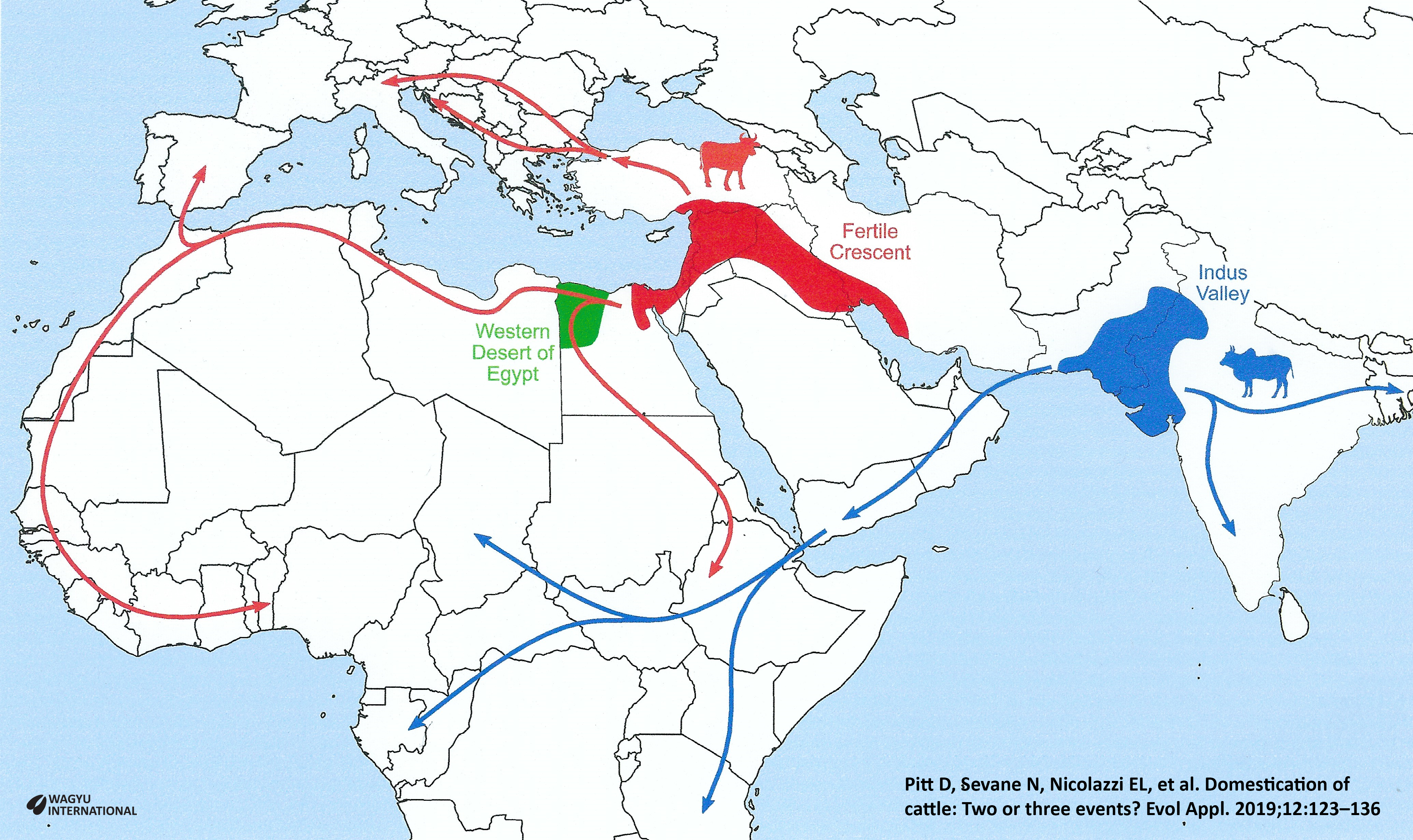
Approximately 1,500 years later a second domestication event took place in the Indus Valley from Bos primigenius nomadicus, separating from the taurine branch to give rise to indicine cattle (Bos indicus) which are also called Zebu cattle. See the blue colour in the map above.
These are the two main domesticated lineages but a third domestication event has been hypothesized to have occurred in north-east Africa giving rise to the divergent African taurine cattle shown in green colour above.
Another event was the migration across Europe.
Domestic cattle in East Asia
Archaeological evidence indicates that domesticated cattle were brought to China from Central and Western Asia during the Neolithic period 5,000 to 4,000 years before present, and were not domesticated from native East Asian aurochs populations. Later on, in a second migration, the East Asian taurine cattle might become widespread all over northern China and margins of the Tibetan Plateau through broader expansion of millet agriculture about 3.6 thousand years ago.
Indicine cattle (Bos indicus) may have dispersed from the Indian subcontinent to East Asia from 3,500 to 2,500 years before present. Chinese indicine cattle inherited around 2.93 % genome component from Banteng Bos javanicus ancestry at least 2.9 thousand years ago (Chen et al., 2018).
Archaeologists have often mistaken aurochs for domesticated cattle, and because wild aurochs could presumably have hybridized with domestic cattle, very little is known about the extinction of aurochs in China (Brian Lander and Katherine Brunson, 2018).
Archaeologists located domestic taurine cattle (Bos taurus) in the upper, middle and lower reaches of the Yellow River regions of China about 4,500 years before present.
However, dogs were the first species to be domesticated in China. They were located in southern Hebei Province about 10,000 years before present. Pigs were the second species to be domesticated in southern Henan about 9,000 years before present. Domestic sheep followed cattle and appeared in Gansu-Qinghai region about 5,600 to 5,000 years before present. Domestic horses appear in eastern Gansu about 4,000–3,600 BP, and finally domestic chickens appear in north-eastern Henan about 3,300 BP.
Each species originated or first appeared at different times and in different regions, but basically all of these species appeared in northern China first (Jing Yuan and Ningning Dong, 2019).
The earlier taurine strand may have migrated from north east China to Japan via the Korean peninsula at quite a late stage in the second century AD. 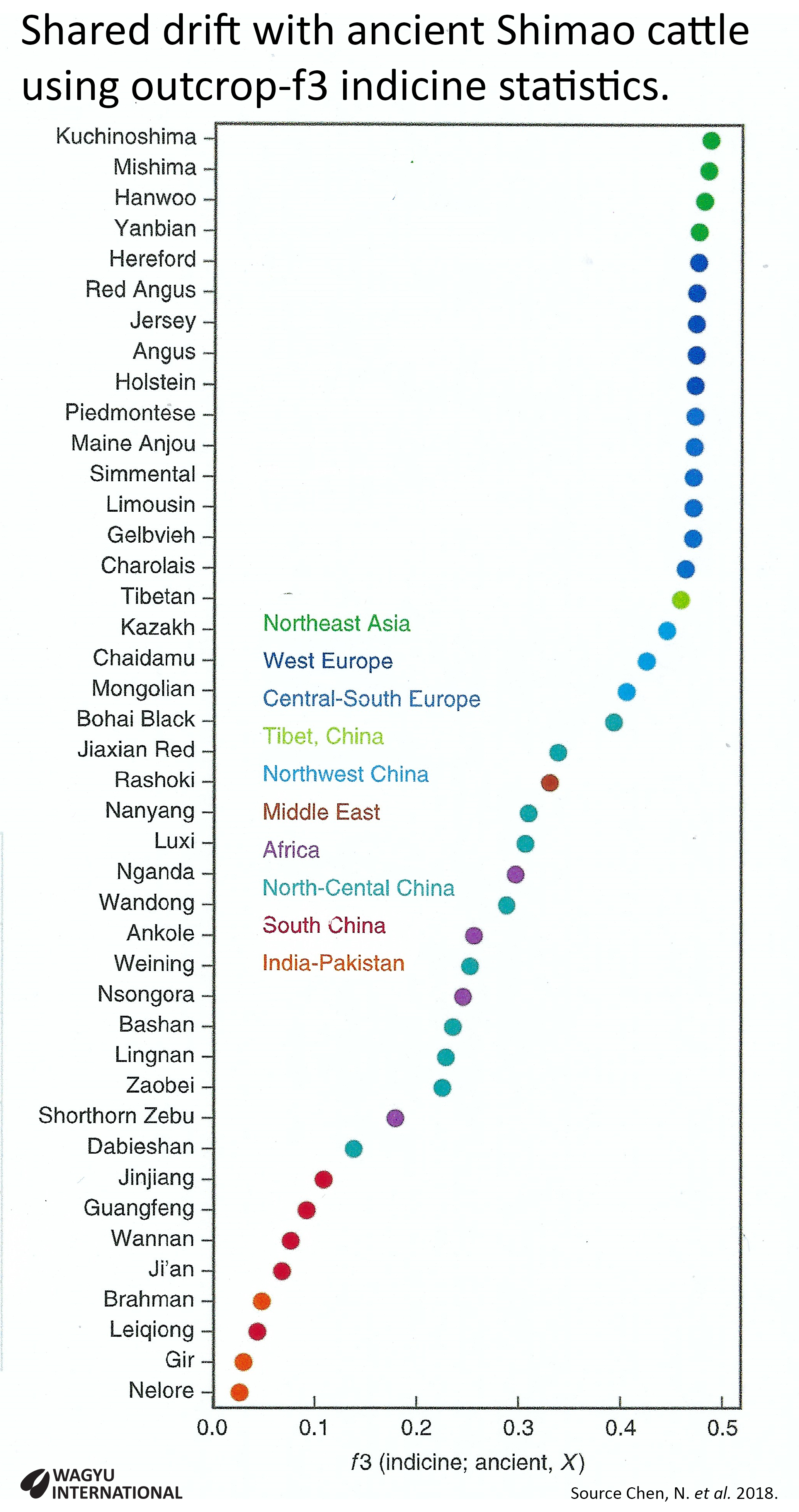 During sequencing of 48 modern breeds and eight East Asian ancient samples, the neighbour-join tree revealed the closest affinity for Korean Hanwoo and native Japanese Mishima and Kuchinoshima cattle. (Chen et al., 2018). Hanwoo are genetically close to Yanbian cattle that are mainly found in North East China (Choi et al., 2016).
During sequencing of 48 modern breeds and eight East Asian ancient samples, the neighbour-join tree revealed the closest affinity for Korean Hanwoo and native Japanese Mishima and Kuchinoshima cattle. (Chen et al., 2018). Hanwoo are genetically close to Yanbian cattle that are mainly found in North East China (Choi et al., 2016).
Haplogroup P is most common in European aurochs. It was unexpectedly identified in 45.9% Japanese Shorthorn together with T haplogroups 1 to 4 which are also found in Japanese Black, Japanese Brown and Japanese Polled breeds. It was considered that the Asian haplogroup P may originate from the ancient Asian population of aurochs because the native Japanese component of Japanese Shorthorn may have been introduced by the importation of cattle that accompanied horses from Siberia and Mongolia to north Japan between 1452 to 1454 (Noda et al., 2018).
To date, haplogroup P in modern cattle has been explained by rare events between female European aurochs and domesticated from the Near East. Chen et al., 2018, reported that haplogroup P was located in two Tibetan cattle and one Hanwoo animal from genome resequencing.
Korean Hanwoo cattle
Hanwoo are indigenous to Korea and share the same origins as Wagyu but they have a longer history.
Native Koeran cattle have been raised in the Korean Peninsula since 2,000 BC. They were raised primarily 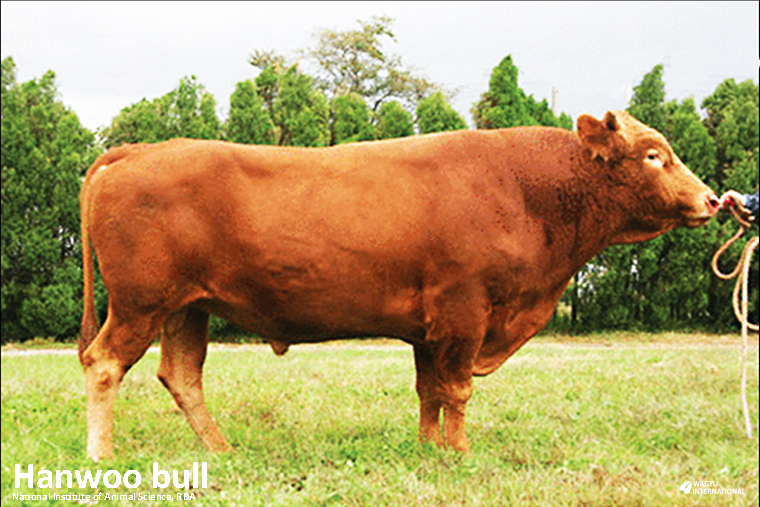 for draught and occasionally for sacrificial rites. Due to the low number of cattle in Korea and also religious and political issues, consumption of beef was low until the economy started to enjoy good growth. Even though Korean cattle in general are known as "Hanwoo" (Han-u and Hanu), the name applies to the most common type which has brown coat colour. "Heugu" have a black face, black is known as "Jeju Black", and "Chikso" has tiger colour.
for draught and occasionally for sacrificial rites. Due to the low number of cattle in Korea and also religious and political issues, consumption of beef was low until the economy started to enjoy good growth. Even though Korean cattle in general are known as "Hanwoo" (Han-u and Hanu), the name applies to the most common type which has brown coat colour. "Heugu" have a black face, black is known as "Jeju Black", and "Chikso" has tiger colour.
In 2011, there were 3 million head of beef cattle in Korea across 160,000 households.
Hanwoo is known to have relatively superior fertility but their slow growth rate and reduced milking yield reduce overall beef production. The Korean cattle industry has aimed to increase the cattle number to meet the growing demand for beef in Korea. With the improvement of the economy more palatable beef is increasing in demand.
Korea had been free of Foot and Mouth diesease for three years but a new outbreak was detected on 3rd December 2014 on pig and cattle farms. There has been culling of herds and vaccination is underway in affected areas with millions of doses of vaccine ordered.
The total number of slaughtered cattle during the 2011 outbreak was 852,000 of which 720,000 were Hanwoo cattle and the remainder were Holstein. Korea is only 42.8% self-sufficient in beef production, with the bulk of the beef imported from Australia, USA, New Zealand, Mexico and Canada (Jo et al., 2012).
Beef consumption
The consumption of meat has increased in Korea from 14 kilogram in 1980 to 40 kilogram in 2010 as a result of a shift from fish to beef. Beef consumption has risen from 3 kilogram to 12 kilogram per capita. The local breed Hanwoo is increasing in share and has risen from 36% in 2011, to 41.9% in 2012 and 44.6% in 2013. This is despite being twice the cost of imported beef as the local beef is considered to be frseher and to have more flavour (Jo et al., 2012).
Fatty acid composition
Samples from 24 month old Australian Angus steers and Korean raised steers were analysed (data from 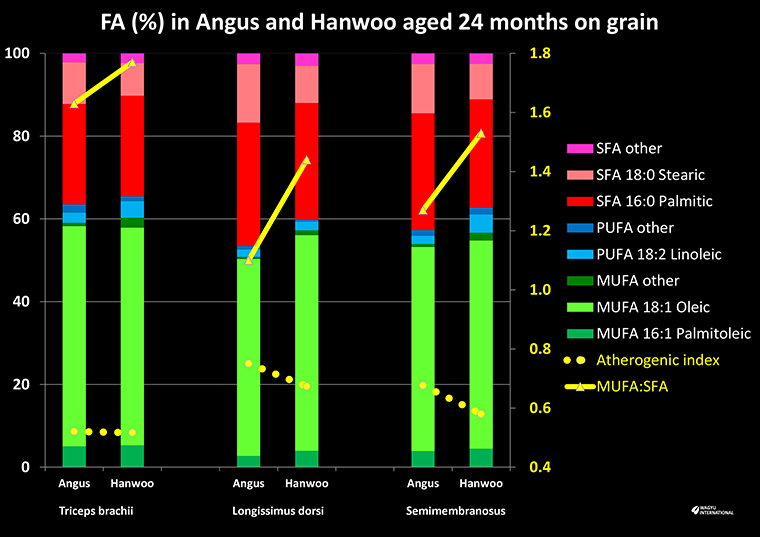 Cho et al., 2005). 18:1 oleic acid was significantly (P < 0.05) higher in Triceps brachii than in the other two muscles. 18:2 linoleic acid was significantly (P < 0.05) higher in Triceps brachii and Semimembranosus than in Longissimus dorsi muscle. For Longissimus muscle, the proportion of SFA was significantly (P < 0.05) highest, while that of PUFA was lowest. Angus had higher omega-3 than that of Hanwoo over the three muscles. Hanwoo contained significantly (P < 0.05) higher omega-6 than Angus. MUFA:SFA was highly significant (P < 0.001) in breed, muscle and breed x muscle and is shown in the chart as the solid yellow line. Atherogenic index is shown as the dotted yellow line and a lower reading is associated with a more favourable fatty acid profile (Cho et al., 2005).
Cho et al., 2005). 18:1 oleic acid was significantly (P < 0.05) higher in Triceps brachii than in the other two muscles. 18:2 linoleic acid was significantly (P < 0.05) higher in Triceps brachii and Semimembranosus than in Longissimus dorsi muscle. For Longissimus muscle, the proportion of SFA was significantly (P < 0.05) highest, while that of PUFA was lowest. Angus had higher omega-3 than that of Hanwoo over the three muscles. Hanwoo contained significantly (P < 0.05) higher omega-6 than Angus. MUFA:SFA was highly significant (P < 0.001) in breed, muscle and breed x muscle and is shown in the chart as the solid yellow line. Atherogenic index is shown as the dotted yellow line and a lower reading is associated with a more favourable fatty acid profile (Cho et al., 2005).
Flavour and taste
Sensory taste panel in Korea from Australian raised Angus and Korean raised Hanwoo beef produced different responses to those reported in the Marbling section. Saturated fatty acids such as 16:0 palmitic acid and 18:0 stearic acid were positively correlated with all sensory traits, while the unsaturated fatty acids (MUFA + PUFA) such as 16:1n7 oleic acid, 18:2n6 linoleic acid, 20:2n6 eicosadienoic acid, 20:3n6 g-linoleic acid, 20:4n6 arachidonic acid and 22:4n6 adrenic acid were negatively correlated with all sensory traits (P < 0.05). In particular, PUFA had significant negative correlation with with tenderness, flavour, juiceness and overall likeness. Individual fatty acids - 14:0 palmitic acid in Korean Hanwoo beef and 22:5n3 in Australian Angus beef (P < 0.01) - might affect the taste in Korean consumers (Cho et al., 2005).
Grading of beef in Korea
Korean consumers have a preference for marbled beef so the grading system in effect since 1992 gives a 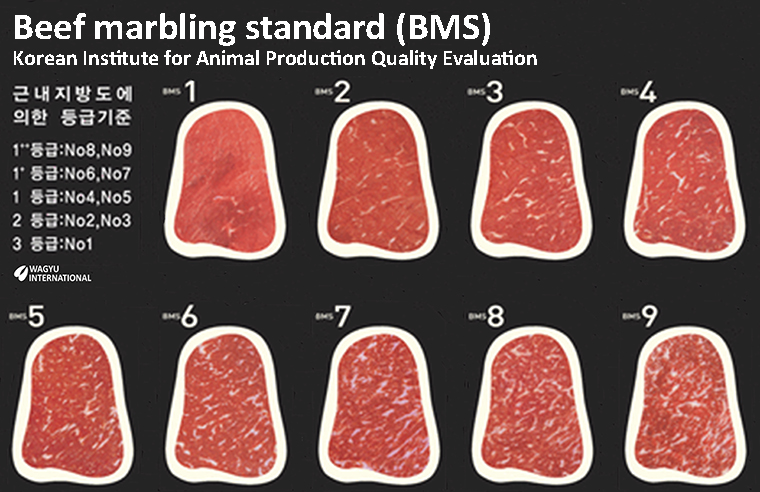 high priority to marbling. The top grade is QG 1++ for Korean beef marbling scores (K-BMS) 8 and 9 for Longissimus dorsi at the 13th rib. 9.2% of Hanwoo slaughtered in 2011 graded QC1++. 22.6% were in QG 1+ from K-BMS 6 and 7. 30.6% were QG 1 with K-BMS 4 and 5. Fat content for the top three QG were 21.48%, 17.61% and 11.02% respectively (Jo et al., 2012).
high priority to marbling. The top grade is QG 1++ for Korean beef marbling scores (K-BMS) 8 and 9 for Longissimus dorsi at the 13th rib. 9.2% of Hanwoo slaughtered in 2011 graded QC1++. 22.6% were in QG 1+ from K-BMS 6 and 7. 30.6% were QG 1 with K-BMS 4 and 5. Fat content for the top three QG were 21.48%, 17.61% and 11.02% respectively (Jo et al., 2012).
References
Chen, N., Cai, Y., Chen, Q. et al. Whole-genome resequencing reveals world-wide ancestry and adaptive introgression events of domesticated cattle in East Asia. Nat Commun 9, 2337 (2018).
Cho, S.H., Park, B.Y., Kim, J.H., Hwang, I.H., Kim, J.H. and J.M. Lee. 2005. Fatty acid profiles and sensory properties of Longissimus dorsi, Triceps brachii and Semimembranosus muscles from Korean Hanwoo and Australian Angus beef. Asian-Aust. J. Anim. 18(12):1786-1792.
Jo, C., Cho., S.H., Chang, J. and K.C. Nam. 2012. Keys to production and processing of Hanwoo beef: A perspective of tradition and science. Animal Frontiers. October 2012 2(4):32-38. With acknowledgement for kind permission from Professor Jo.
Noda, A. Yonesaka, R., Sasazaki, S., H. Manneen, 2018. The mtDNA haplogroup P of modern Asian cattle: A genetic legacy of Asian aurochs?
Pitt D, Sevane N, Nicolazzi EL, et al. Domestication of cattle: Two or three events? Evol Appl. 2019;12:123–136.
Yuan, Jing and Ningning Dong, 2019. Rethinking the origins of animal domestication in China. Chinese Archaeology 19 (2019): 195–200.
Return to top of page and Menu
Return to other countries on Global
